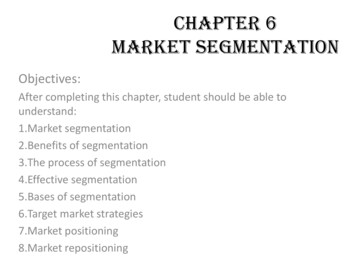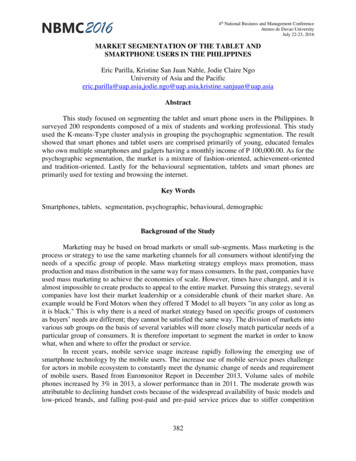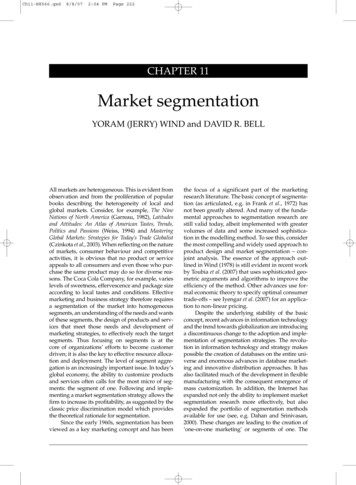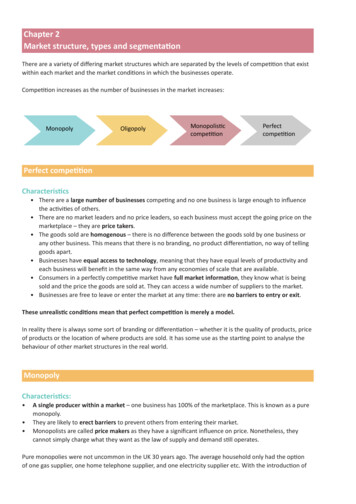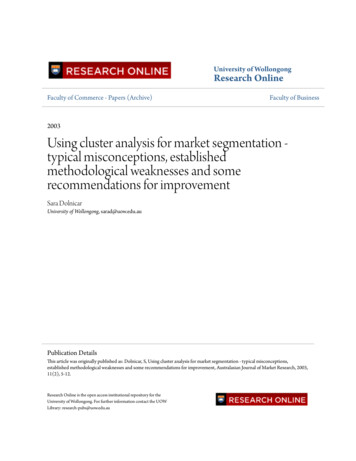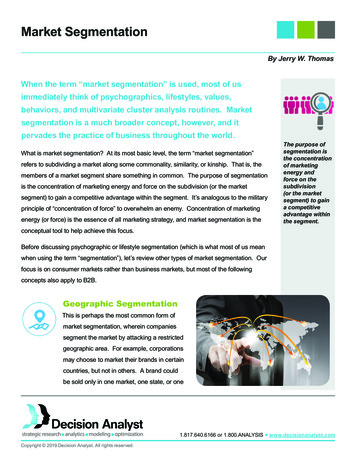
Transcription
Market SegmentationBy Jerry W. ThomasWhen the term “market segmentation” is used, most of usimmediately think of psychographics, lifestyles, values,behaviors, and multivariate cluster analysis routines. Marketsegmentation is a much broader concept, however, and itpervades the practice of business throughout the world.What is market segmentation? At its most basic level, the term “market segmentation”refers to subdividing a market along some commonality, similarity, or kinship. That is, themembers of a market segment share something in common. The purpose of segmentationis the concentration of marketing energy and force on the subdivision (or the marketsegment) to gain a competitive advantage within the segment. It’s analogous to the militaryprinciple of “concentration of force” to overwhelm an enemy. Concentration of marketingenergy (or force) is the essence of all marketing strategy, and market segmentation is theThe purpose ofsegmentation isthe concentrationof marketingenergy andforce on thesubdivision(or the marketsegment) to gaina competitiveadvantage withinthe segment.conceptual tool to help achieve this focus.Before discussing psychographic or lifestyle segmentation (which is what most of us meanwhen using the term “segmentation”), let’s review other types of market segmentation. Ourfocus is on consumer markets rather than business markets, but most of the followingconcepts also apply to B2B.Geographic SegmentationThis is perhaps the most common form ofmarket segmentation, wherein companiessegment the market by attacking a restrictedgeographic area. For example, corporationsmay choose to market their brands in certaincountries, but not in others. A brand couldbe sold only in one market, one state, or one1.817.640.6166 or 1.800.ANALYSIS www.decisionanalyst.comCopyright 2019 Decision Analyst. All rights reserved.
Decision Analyst: Market Segmentationregion of the United States. Many restaurant chains focus on a limited geographic area to achieveconcentration of force. Regional differences in consumer preferences exist, and this often providesa basis for geographic specialization. For example, a company might choose to market its redeyegravy only in the southeastern U.S. Likewise, a picante sauce might concentrate its distribution andadvertising in the Southwest. A chainsaw company might only market its products in areas withforests. Geographic segmentation can take many forms (urban versus rural, north versussouth, seacoasts versus interior, warm areas versus cold, high-humidity areas versus dryareas, high-elevation versus low-elevation areas, and so on). These examples also reveal thatgeographic segmentation is sometimes a surrogate for (or a means to) other types of segmentation.Distribution SegmentationDifferent markets can be reached through different channels of distribution. For example, acompany might segment the “tick and flea collar” market by selling the product to supermarketsunder one brand name, to mass merchandisers under another brand name, to pet stores underanother brand name, and to veterinarians under yet another brand name. This type of distributionalsegmentation is common, especially among small companies that grant each channel a uniquebrand to gain distribution within that channel. Other examples of distributional segmentation wouldbe an upscale line of clothing sold only in expensive department stores, or a luxury hair shampoosold only through upscale beauty salons.Media SegmentationWhile not common, media segmentation is sometimes a possibility. It is based on the fact thatdifferent media tend to reach different audiences. If a brand pours all of its budget into one media,it can possibly dominate the segment of the market that listens to that radio station or reads thatmagazine. Media segmentation is most often practiced by companies that have some control overthe media and can somehow discourage competitors from using that media.Price SegmentationPrice segmentation is common and widely practiced. Variation in household incomes creates anopportunity for segmenting some markets along a price dimension. If personal incomes rangefrom low to high, the reasoning goes, then a company should offer some cheap products, somemedium-priced ones, and some expensive ones. This type of price segmentation is well illustrated2Copyright 2019 Decision Analyst. All rights reserved.
Decision Analyst: Market Segmentationby the range of automotive brands marketed by General Motors, historically. Chevrolet, Pontiac,Oldsmobile, Buick, and Cadillac varied in price (and status) along a clearly defined spectrum toappeal to successively higher income groups.Demographic SegmentationGender, age, income, housing type, and education level are common demographic variables. Somebrands are targeted only to women, others only to men. Music streaming services tend to betargeted to the young, while hearing aids are targeted to the elderly. Education levels often definemarket segments. For instance, private elementary schools might define their target market ashighly educated households containing women of childbearing age. Demographic segmentationalmost always plays some role in a segmentation strategy.Time SegmentationTime segmentation is less common, but can be highly effective. Some stores stay open later thanothers, or stay open on weekends. Some products are sold only at certain times of the year (e.g.,Christmas cards, fireworks). Chili is marketed more aggressively in the fall, with the onset of coolerweather. Football is played in the fall, basketball in the winter and spring, and baseball in the springand summer (or at least this used to be the pattern). The Olympics come along every four years.Department stores sometimes schedule midnight promotional events. The time dimension can bean interesting basis for segmentation.Occasion-BasedSegmentationPeople tend to behave differently, andthink differently, at different times oroccasions. For example, dietary habitsand preferences vary by occasion:breakfast is different from dinner; eating outon a Friday night is different from grabbinglunch during the week; Thanksgiving dinneris different from most other dinners. Thesetypes of differences can be the basis forCopyright 2019 Decision Analyst. All rights reserved.3
Decision Analyst: Market Segmentationsegmenting a market. If the goal is to develop new product development templates for a restaurantchain, then occasion-based segmentation might be a good solution. If the goal, however, is todevelop the strategic positioning and advertising messages for a new smartphone or a new car,then occasion-based segmentation would not be applicable. In these cases, the goal is one optimalsolution, and the occasions do not matter.Markets can be also segmented by hobbies, by political affiliation, by religion, by special interestgroups, by sports team loyalties, by university attended, and by hundreds of other variables. Youare only limited by your marketing imagination.Psychographic or LifestyleSegmentationLastly, we come to psychographic (or lifestyle) segmentation,based upon multivariate analyses of consumer attitudes,values, behaviors, emotions, perceptions, beliefs,needs, benefits, wishes, and interests. Psychographicsegmentation is a legitimate way to segment a market, if wecan identify the proper segmentation variables (or lifestylestatements, words, pictures, etc.).Qualitative research techniques (focus groups, depth interviews, ethnography) become invaluableat this stage. Qualitative research provides the insight, the conceptual knowledge, andthe consumer’s exact language necessary to design the segmentation questionnaire. Typically,verbatim comments from consumers are used to build batteries of psychographic orlifestyle statements (these two terms are used interchangeably). A large representative sampleof consumers (generally, 1,000 or more) are then asked about the degree to which they agree ordisagree with each statement.For example, if you were designing a market segmentation questionnaire for an airline, you mightconduct a series of depth interviews to help design the questionnaire. You probably would includea behavioral section (frequency of flying, how purchase tickets, who travel with, cities flown to,where sit, airlines flown, money spent on airline tickets, etc.). You would include a major section onattitudes toward air travel (motivations for air travel, fears related to air travel, positive emotions offlying, attitudes about airline employees, checking luggage, buying tickets, and so forth). You would4Copyright 2019 Decision Analyst. All rights reserved.
Decision Analyst: Market Segmentationalso want to include a section on perceptions of the different airlines; that is, their “brand images.”You could go further and add a section on media consumption or personal values as well. It is atthis point that you realize the questionnaire is too long, and you have to make some hard decisionsabout what questions or statements to include.The method of data collection is very important, because the questionnaire is so long (often 45 to60 minutes in length). The telephone is not recommended for segmentation studies because ofquestionnaire length. Moreover, the various rating scales and attitudinal statements are difficult tocommunicate by phone, and the resulting phone data tends to be “insensitive” and rife with “noise.”In-person interviews, online surveys (or even mail surveys) are much better. Rating scales andattitudinal statements can be seen and fully comprehended by respondents. Seeing is much betterthan hearing, and it produces more accurate answers. Online surveys are especially valuable forsegmentation studies, since respondents can take the survey at a time of their own choosing whenthey can give it their full, undivided attention. A mail survey offers some of the same advantages,but without the questionnaire controls, checks, and safeguards built into an online survey.Analytical MethodsMost segmentation analyses are based upon various types of “cluster analysis,” which is a set of well-definedstatistical procedures that group people according to the proximity of their ratings. Unfortunately, cluster analysis(regardless of its many types and forms) has inherent limitations and seldom yields coherent market segments.Cluster analysis routines tend to ignore the pattern of respondent ratings and rely primarily upon the proximity ofrespondent ratings. Too often this leads to clusters, or market segments, that don’t seem to make much sensewhen cross-tabulated against the original segmentation variables. Another limitation of clustering approaches isthat all statements are treated as equal, whereas, in truth, some statements might be much more important thanothers in explaining consumer behavior in a particular product category.A better way to achieve a good psychographicsegmentation is to first identify the statements that aremore important (i.e., the statements that tend to explainor cause specific consumer behaviors). Correlationanalysis and regression can be used for this purpose.Factor analysis is also a powerful technique to identifythe statements and groups of statements that account formuch of the variance in the attitudinal data set. Directly,Copyright 2019 Decision Analyst. All rights reserved.5
Decision Analyst: Market Segmentationand indirectly, these techniques can help you identify the most important statements (i.e., attitudes, perceptions,values). Then these statements become the inputs to the final segmentation analysis. Many different methods canbe used to “cluster” or group the statements at this point.The final step is to attach a segment code to each marketsegment identified and then cross-tab all of the questionnairevariables by the segments. You must then study thesegments, and the attitudes/statements that make up eachsegment, to make sure they make sense and hang together.If the segmentation results don’t make sense, then youhave to go back, change some of your assumptions ormethods, rerun the analysis, and repeat the cross-tabexercise to apply the “common sense” validity check.Common MistakesSegmentation studies tend to be large and complicated, so it’s easy for errors and mistakes to be made. Some ofthe most common mistakes:1. Segmenting a segment. For example, someone might want to segment the market for widgets among 18- to24-year-olds who live in Vermont and buy brand XYZ. As is evident, the client is asking that a tiny sliver of themarket be segmented. True, this tiny sliver can be segmented, but rarely are the resulting segments of any value,because they are just too small. General rule: segment the whole market, including all age groups. The marketshould be broadly defined for a segmentation analysis to be most effective. In other words, don’t preordain theresults by sampling restrictions.2. Overlooking the “universals.” Many attitudinal statements in the questionnaire will not show up in the finalsegments, because they tend to be the same across all segments. Statements that everyone agrees with oreveryone disagrees with (we call them “universals”) cannot explain much in the multivariate analyses.Variables have to move up and down for the multivariate analysis to work. The highest-rated variables, and thelowest-rated, are likely to fall out of the multivariate equations. However, you should always look at theseuniversal statements. Any one of them might be the basis for a positioning or a strategy that wouldappeal to everyone. If you find something unique that appeals to everyone, the heck with segmentation.Go for the whole hog.6Copyright 2019 Decision Analyst. All rights reserved.
Decision Analyst: Market Segmentation3. Creating too many segments. There is a practical limit to the size of segments that companies can effectivelytarget. If you create more than four or five market segments, you run the risk that the resulting segments will betoo small to target, at
Market Segmentation When the term “market segmentation” is used, most of us immediately think of psychographics, lifestyles, values, behaviors, and multivariate cluster analysis routines. Market segmentation is a much broader concept, however, and it pervades the practice of business throughout the world. What is market segmentation? At its most basic level, the term “market segmentation”File Size: 1MBPage Count: 10

